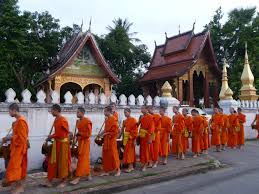Luang Prabang: City of the Royal Buddha
 The host of Tha Heua Me Guesthouse greets me with a smile on the porch and points to the simple meal prepared on the teak table beside her: sticky rice in a woven bamboo basket. I nod to her in ‘thanks’ – neither of us speaking the others’ language – take the rice, slip on my shoes, and begin my walk towards Sakkaline Road. The first rays of sunlight seep through the thick morning fog as I pass stately brick buildings adorned with plaited bamboo panels and balconies, the architectural vestiges of France’s colonial rule over Laos. Upon arriving at Luang Prabang’s main avenue, I am met by a long procession of barefoot monks in plain orange garb making their way through throngs of locals and tourists, all gathered at the crack of dawn to partake in a tradition that stretches back centuries. I kneel at the curbside with rice in hand waiting for an empty-handed monk to accept my offering. A few moments later, I am locking eyes with a young bareheaded man; his expression is at once one of gratitude and of poise. This will be the only meal he eats all day.
The host of Tha Heua Me Guesthouse greets me with a smile on the porch and points to the simple meal prepared on the teak table beside her: sticky rice in a woven bamboo basket. I nod to her in ‘thanks’ – neither of us speaking the others’ language – take the rice, slip on my shoes, and begin my walk towards Sakkaline Road. The first rays of sunlight seep through the thick morning fog as I pass stately brick buildings adorned with plaited bamboo panels and balconies, the architectural vestiges of France’s colonial rule over Laos. Upon arriving at Luang Prabang’s main avenue, I am met by a long procession of barefoot monks in plain orange garb making their way through throngs of locals and tourists, all gathered at the crack of dawn to partake in a tradition that stretches back centuries. I kneel at the curbside with rice in hand waiting for an empty-handed monk to accept my offering. A few moments later, I am locking eyes with a young bareheaded man; his expression is at once one of gratitude and of poise. This will be the only meal he eats all day.Later in the day, my college buddy and I, en route to one of Luang Prabang’s French bistros, stop by Wat Xieng Thong, a glittering monument honoring the twin pillars of ancient Lao society: the King and the Buddha. Upon wresting power from the French in 1945, the victorious communist party moved Laos’ political capitol to Vientiane. Nonetheless, Luang Prabang remains the spiritual beating heart of the nation. Though the princes of Laos languish in exile, the royal family may be consoled that the memory of their ancestors endures in the gilded funeral urns of the stupa inside this splendid monument. It is not just Wat Xieng Thong that dazzles. On each cobblestone corner of town, another enigmatic Wat awaits discovery. No sign of the communist regime. It’s as if this Buddhist kingdom never left its royal capital.
Guest Post by Ted Shabecoff
